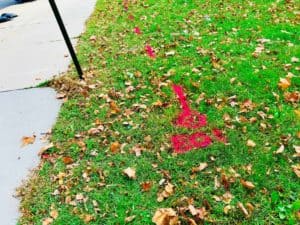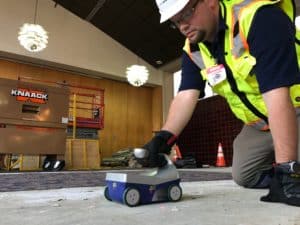The common misconception with most state-run 811 (call before you dig) programs is that they locate underground utilities for free. The fact, however, is that the 811 system doesn’t locate utilities at all. It is simply a distribution hub that notifies utility companies that someone is digging or planning to dig on or near their facilities. When you call 811, you are calling a state-run or non-profit organization that will collect all of the important information about who you are, what you are doing, and where you are doing it. They will then disseminate that information to any utility company or municipality that has utilities in the near vicinity of your proposed work. The utility company must be a “participating member” of the 811 system for this to work. If a facility operation is not a member, then 811 doesn’t have their information on file, and likely has no idea that the facility operator even exists, let alone if they have utilities near the excavation area. And this is where we learn about our first problem with the 811 system.
Non-Member Companies

 Because non-member companies do not have their data stored with the 811 system, they are not notified about the excavation. This will leave unmarked utilities in your work area, which can cause not only expensive utility damages but could be a major safety hazard as well. Luckily, most of the big boys are member companies. In general, smaller utility providers like local fiber companies are the most common facility provider that is a non-member. Unfortunately, many local and regional propane suppliers are non-member companies as well. They consider the propane gas line that feeds most residential homes to be a private utility. What does this mean for your excavation? No one will locate it, because only the homeowner is responsible for it, which brings us to our next problem.
Because non-member companies do not have their data stored with the 811 system, they are not notified about the excavation. This will leave unmarked utilities in your work area, which can cause not only expensive utility damages but could be a major safety hazard as well. Luckily, most of the big boys are member companies. In general, smaller utility providers like local fiber companies are the most common facility provider that is a non-member. Unfortunately, many local and regional propane suppliers are non-member companies as well. They consider the propane gas line that feeds most residential homes to be a private utility. What does this mean for your excavation? No one will locate it, because only the homeowner is responsible for it, which brings us to our next problem.
Utility Companies Only Mark What They Own
Like most companies, utility companies will only do the bare minimum required by law. This is especially true if doing a little extra will open up a massive amount of liability. Because of the extreme cost of some underground utility damages, facility owners are reluctant to allow their field technicians to locate just any underground utility. They are often restricted to locate only the utility that the company operates or owns. So what happens to the utilities that are privately owned? They get located the hard way, with your excavator or drill rig.
Over Worked and Underpaid
 Let’s face it, utility companies and energy suppliers are not truly in it to make our lives better, despite what their marketing departments want you to believe. It’s a business, through and through. They will do anything to increase profits and decrease expenses. This is why most utility companies and service providers will out source their 811 requests to a contractor. On paper, this makes sense and looks well and good, but the reality of the situation is dismal. Many of these contract companies, USIC, UtiliQuest, and Premier Utility Services to name a few, will bid on many contracts with multiple utility companies in a concentrated area. This allows them to submit incredibly low bids that most companies couldn’t survive on. Because they are representing up 9 or 10 utility companies for each ticket they complete, they are able to turn a profit and keep the company afloat. The problem with this business model is that the contracting company that is ultimately responsible for the paint you are digging around has a low-profit margin and must do anything and everything to lower their costs. They accomplish this by hiring a less qualified workforce (at lower wages) and piling tickets onto their technicians that can’t possibly be completed by their due dates or deadlines. Ever wonder why your ticket was delayed without notice? Now you know. They technicians get stressed out and begin cutting corners to complete the work. Inevitably, this leads to an increase in utility damages, which results in the termination of that employee. The cycle starts again with a new hire. Because the turnover rate at these companies is so high, it is impossible to fill the role with a highly trained and experienced technician.
Let’s face it, utility companies and energy suppliers are not truly in it to make our lives better, despite what their marketing departments want you to believe. It’s a business, through and through. They will do anything to increase profits and decrease expenses. This is why most utility companies and service providers will out source their 811 requests to a contractor. On paper, this makes sense and looks well and good, but the reality of the situation is dismal. Many of these contract companies, USIC, UtiliQuest, and Premier Utility Services to name a few, will bid on many contracts with multiple utility companies in a concentrated area. This allows them to submit incredibly low bids that most companies couldn’t survive on. Because they are representing up 9 or 10 utility companies for each ticket they complete, they are able to turn a profit and keep the company afloat. The problem with this business model is that the contracting company that is ultimately responsible for the paint you are digging around has a low-profit margin and must do anything and everything to lower their costs. They accomplish this by hiring a less qualified workforce (at lower wages) and piling tickets onto their technicians that can’t possibly be completed by their due dates or deadlines. Ever wonder why your ticket was delayed without notice? Now you know. They technicians get stressed out and begin cutting corners to complete the work. Inevitably, this leads to an increase in utility damages, which results in the termination of that employee. The cycle starts again with a new hire. Because the turnover rate at these companies is so high, it is impossible to fill the role with a highly trained and experienced technician.
Public records maintained by the State Corporation Commission show alleged violations by USIC in Norfolk, Virginia Beach, Chesapeake, Newport News, Hampton, Williamsburg, York County and elsewhere in Virginia. Equipment damaged across the state includes plastic and steel gas pipes, electric lines, a 12-inch iron water pipe and a copper telecommunication line.- The Virginian Pilot
How we Bridge The Gap
Utility Locator, LLC can help bridge the gap by locating all underground utilities on your project site. We can confirm the 811 mark-outs, as well as identify other underground utilities in the area that were either mis-marked, or missed altogether. Our technicians will scan your project or work site for all underground utilities, including structures. We are able to out perform our counter parts in the 811 system because we take the time to be thorough and we locate all utilities, not just a selected few. We care about our customers and their problems, and we strive to solve them no matter how challenging.









